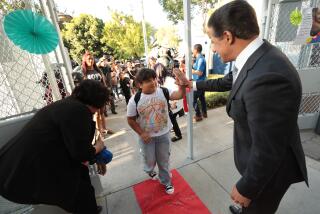Hands-On Science Tasks Are Part of Test for 5th-Graders
Forget No. 2 pencils. For the state’s newest standardized test, students use rocks, trucks, round metal washers and an army of plastic insects.
Introduced this year, the fifth-grade California Learning Assessment System test includes hands-on science tasks and social science exercises gauging knowledge of California and U.S. geography and history, according to copies obtained by The Times.
The most innovative portion of the exam--which has received little attention amid the furor over the language arts components of CLAS--is Science Booklet 2, in which students conduct a variety of experiments to plan a “critter museum.”
Working in groups, children test rocks’ durability, analyze a loaded truck’s ability to move on different paths and group bugs according to their anatomy and characteristics.
First, students must select a material for the benches and tables in the museum’s picnic area and explain why they believe it will hold up best under wind, rain and abuse. Then, test-takers choose whether to truck material to the museum site along smooth or gravel roads, using a rudimentary system made from a paper cup, a piece of string and metal washers.
Finally, students place tiny plastic bugs in groups and fill out information cards for a makeshift museum exhibit.
Science Booklet 1 is more straightforward, with eight standard multiple-choice questions, and two more multiple-choice questions in which students must explain their answers. But the content is thoroughly geared to students’ lives and reflects California’s ethnically diverse student population.
One question concerns Mrs. Coe’s fifth-grade science class field trip. Another shows Maria’s record of the temperature in her classroom. Several follow up on the Rodriguez or Shafik or Lee families’ hiking, camping and picnic trips.
Through the situations designed around children, CLAS tests students’ knowledge of plant life, astronomy, electric circuits, outer space, animal digestion and weather.
The second part of the fifth-grade test--social science and history--is the most traditional form of California’s revolutionary performance-based assessments. Students label the rivers and mountains on a U.S. map, answer eight multiple-choice questions and write one or two essays, depending on which of six versions of the test they are given.
One version shows students a poster advertising a slave auction and asks for an essay about “why slaves were used in the South,” “how slaves found ways to resist,” “what being slaves meant for a Negro family” and “how slaves developed a culture to survive their day-to-day lives.”
Another essay asks why people settled the colonies, while a third instructs children to pretend it is the time of the American Revolution and “write a letter to a friend about which side you would support.”
Other essay assignments concern Roger Williams and Anne Hutchinson, pioneer trails (students also must label a map), the New England Colonial economy, the Declaration of Independence and the sea routes to the Gold Rush.
More to Read
Sign up for Essential California
The most important California stories and recommendations in your inbox every morning.
You may occasionally receive promotional content from the Los Angeles Times.










